Benedict Flade
Probabilistic Mission Design in Neuro-Symbolic Systems
Dec 25, 2024



Abstract:Advanced Air Mobility (AAM) is a growing field that demands accurate modeling of legal concepts and restrictions in navigating intelligent vehicles. In addition, any implementation of AAM needs to face the challenges posed by inherently dynamic and uncertain human-inhabited spaces robustly. Nevertheless, the employment of Unmanned Aircraft Systems (UAS) beyond visual line of sight (BVLOS) is an endearing task that promises to enhance significantly today's logistics and emergency response capabilities. To tackle these challenges, we present a probabilistic and neuro-symbolic architecture to encode legal frameworks and expert knowledge over uncertain spatial relations and noisy perception in an interpretable and adaptable fashion. More specifically, we demonstrate Probabilistic Mission Design (ProMis), a system architecture that links geospatial and sensory data with declarative, Hybrid Probabilistic Logic Programs (HPLP) to reason over the agent's state space and its legality. As a result, ProMis generates Probabilistic Mission Landscapes (PML), which quantify the agent's belief that a set of mission conditions is satisfied across its navigation space. Extending prior work on ProMis' reasoning capabilities and computational characteristics, we show its integration with potent machine learning models such as Large Language Models (LLM) and Transformer-based vision models. Hence, our experiments underpin the application of ProMis with multi-modal input data and how our method applies to many important AAM scenarios.
The Constitutional Filter
Dec 24, 2024



Abstract:Predictions in environments where a mix of legal policies, physical limitations, and operational preferences impacts an agent's motion are inherently difficult. Since Neuro-Symbolic systems allow for differentiable information flow between deep learning and symbolic building blocks, they present a promising avenue for expressing such high-level constraints. While prior work has demonstrated how to establish novel planning setups, e.g., in advanced aerial mobility tasks, their application in prediction tasks has been underdeveloped. We present the Constitutional Filter (CoFi), a novel filter architecture leveraging a Neuro-Symbolic representation of an agent's rules, i.e., its constitution, to (i) improve filter accuracy, (ii) leverage expert knowledge, (iii) incorporate deep learning architectures, and (iv) account for uncertainties in the environments through probabilistic spatial relations. CoFi follows a general, recursive Bayesian estimation setting, making it compatible with a vast landscape of estimation techniques such as Particle Filters. To underpin the advantages of CoFi, we validate its performance on real-world marine data from the Automatic Identification System and official Electronic Navigational Charts.
StaR Maps: Unveiling Uncertainty in Geospatial Relations
Dec 24, 2024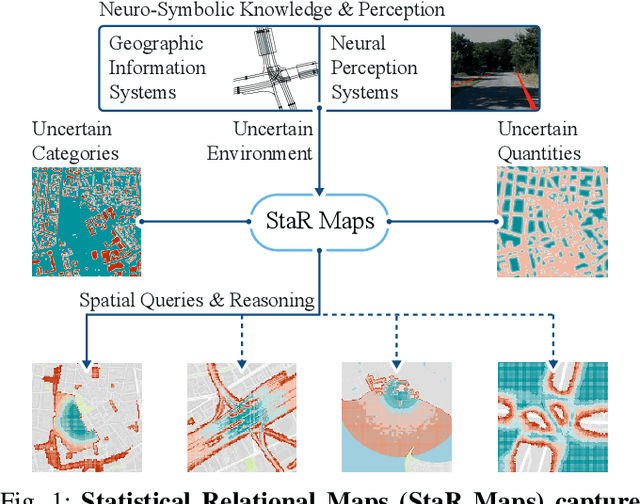



Abstract:The growing complexity of intelligent transportation systems and their applications in public spaces has increased the demand for expressive and versatile knowledge representation. While various mapping efforts have achieved widespread coverage, including detailed annotation of features with semantic labels, it is essential to understand their inherent uncertainties, which are commonly underrepresented by the respective geographic information systems. Hence, it is critical to develop a representation that combines a statistical, probabilistic perspective with the relational nature of geospatial data. Further, such a representation should facilitate an honest view of the data's accuracy and provide an environment for high-level reasoning to obtain novel insights from task-dependent queries. Our work addresses this gap in two ways. First, we present Statistical Relational Maps (StaR Maps) as a representation of uncertain, semantic map data. Second, we demonstrate efficient computation of StaR Maps to scale the approach to wide urban spaces. Through experiments on real-world, crowd-sourced data, we underpin the application and utility of StaR Maps in terms of representing uncertain knowledge and reasoning for complex geospatial information.
Hybrid Many-Objective Optimization in Probabilistic Mission Design for Compliant and Effective UAV Routing
Dec 24, 2024Abstract:Advanced Aerial Mobility encompasses many outstanding applications that promise to revolutionize modern logistics and pave the way for various public services and industry uses. However, throughout its history, the development of such systems has been impeded by the complexity of legal restrictions and physical constraints. While airspaces are often tightly shaped by various legal requirements, Unmanned Aerial Vehicles (UAV) must simultaneously consider, among others, energy demands, signal quality, and noise pollution. In this work, we address this challenge by presenting a novel architecture that integrates methods of Probabilistic Mission Design (ProMis) and Many-Objective Optimization for UAV routing. Hereby, our framework is able to comply with legal requirements under uncertainty while producing effective paths that minimize various physical costs a UAV needs to consider when traversing human-inhabited spaces. To this end, we combine hybrid probabilistic first-order logic for spatial reasoning with mixed deterministic-stochastic route optimization, incorporating physical objectives such as energy consumption and radio interference with a logical, probabilistic model of legal requirements. We demonstrate the versatility and advantages of our system in a large-scale empirical evaluation over real-world, crowd-sourced data from a map extract from the city of Paris, France, showing how a network of effective and compliant paths can be formed.
Error Decomposition for Hybrid Localization Systems
Oct 18, 2024Abstract:Future advanced driver assistance systems and autonomous vehicles rely on accurate localization, which can be divided into three classes: a) viewpoint localization about local references (e.g., via vision-based localization), b) absolute localization about a global reference system (e.g., via satellite navigation), and c) hybrid localization, which presents a combination of the former two. Hybrid localization shares characteristics and strengths of both absolute and viewpoint localization. However, new sources of error, such as inaccurate sensor-setup calibration, complement the potential errors of the respective sub-systems. Therefore, this paper introduces a general approach to analyzing error sources in hybrid localization systems. More specifically, we propose the Kappa-Phi method, which allows for the decomposition of localization errors into individual components, i.e., into a sum of parameterized functions of the measured state (e.g., agent kinematics). The error components can then be leveraged to, e.g., improve localization predictions, correct map data, or calibrate sensor setups. Theoretical derivations and evaluations show that the algorithm presents a promising approach to improve hybrid localization and counter the weaknesses of the system's individual components.
Human-Based Risk Model for Improved Driver Support in Interactive Driving Scenarios
Oct 03, 2024



Abstract:This paper addresses the problem of human-based driver support. Nowadays, driver support systems help users to operate safely in many driving situations. Nevertheless, these systems do not fully use the rich information that is available from sensing the human driver. In this paper, we therefore present a human-based risk model that uses driver information for improved driver support. In contrast to state of the art, our proposed risk model combines a) the current driver perception based on driver errors, such as the driver overlooking another vehicle (i.e., notice error), and b) driver personalization, such as the driver being defensive or confident. In extensive simulations of multiple interactive driving scenarios, we show that our novel human-based risk model achieves earlier warning times and reduced warning errors compared to a baseline risk model not using human driver information.
Towards Probabilistic Clearance, Explanation and Optimization
Jun 21, 2024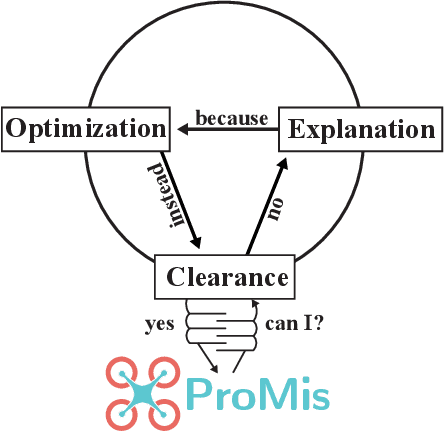
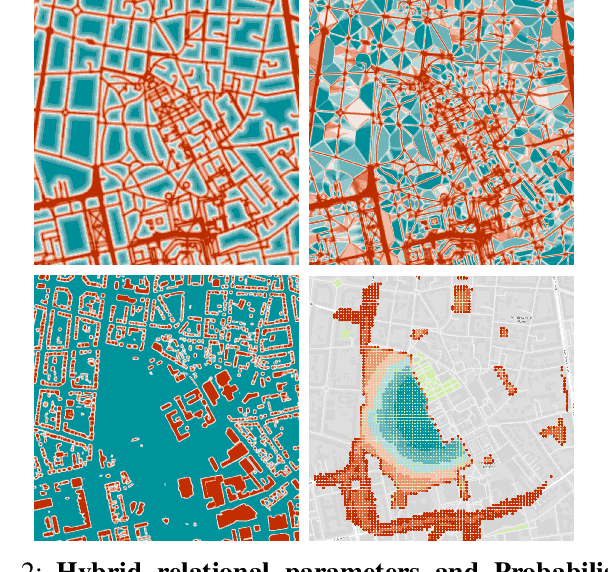
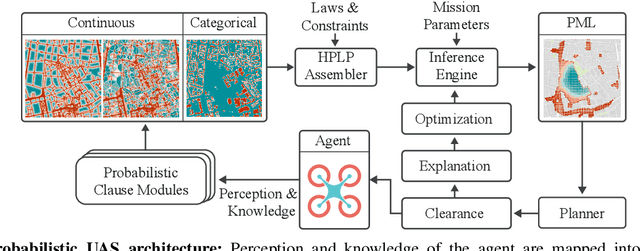

Abstract:Employing Unmanned Aircraft Systems (UAS) beyond visual line of sight (BVLOS) is an endearing and challenging task. While UAS have the potential to significantly enhance today's logistics and emergency response capabilities, unmanned flying objects above the heads of unprotected pedestrians induce similarly significant safety risks. In this work, we make strides towards improved safety and legal compliance in applying UAS in two ways. First, we demonstrate navigation within the Probabilistic Mission Design (ProMis) framework. To this end, our approach translates Probabilistic Mission Landscapes (PML) into a navigation graph and derives a cost from the probability of complying with all underlying constraints. Second, we introduce the clearance, explanation, and optimization (CEO) cycle on top of ProMis by leveraging the declaratively encoded domain knowledge, legal requirements, and safety assertions to guide the mission design process. Based on inaccurate, crowd-sourced map data and a synthetic scenario, we illustrate the application and utility of our methods in UAS navigation.
Mission Design for Unmanned Aerial Vehicles using Hybrid Probabilistic Logic Program
Jun 05, 2024Abstract:Advanced Air Mobility (AAM) is a growing field that demands a deep understanding of legal, spatial and temporal concepts in navigation. Hence, any implementation of AAM is forced to deal with the inherent uncertainties of human-inhabited spaces. Enabling growth and innovation requires the creation of a system for safe and robust mission design, i.e., the way we formalize intentions and decide their execution as trajectories for the Unmanned Aerial Vehicle (UAV). Although legal frameworks have emerged to govern urban air spaces, their full integration into the decision process of autonomous agents and operators remains an open task. In this work we present ProMis, a system architecture for probabilistic mission design. It links the data available from various static and dynamic data sources with legal text and operator requirements by following principles of formal verification and probabilistic modeling. Hereby, ProMis enables the combination of low-level perception and high-level rules in AAM to infer validity over the UAV's state-space. To this end, we employ Hybrid Probabilistic Logic Programs (HPLP) as a unifying, intermediate representation between perception and action-taking. Furthermore, we present methods to connect ProMis with crowd-sourced map data by generating HPLP atoms that represent spatial relations in a probabilistic fashion. Our claims of the utility and generality of ProMis are supported by experiments on a diverse set of scenarios and a discussion of the computational demands associated with probabilistic missions.
Online and Predictive Warning System for Forced Lane Changes using Risk Maps
Mar 15, 2023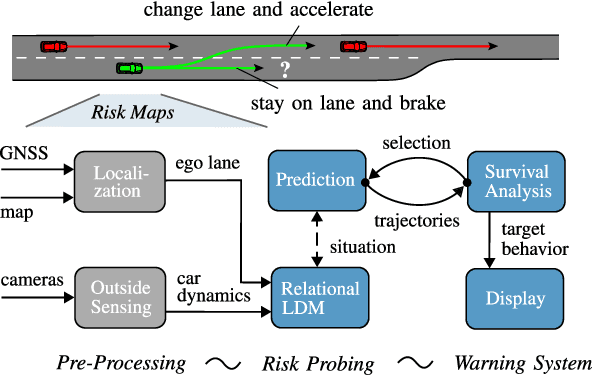

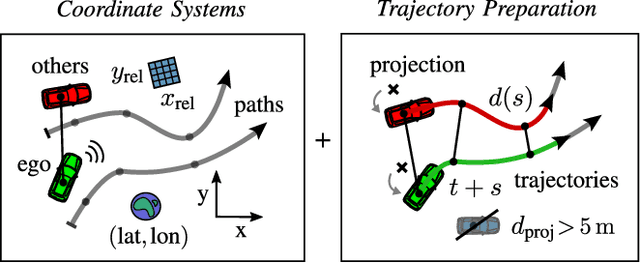
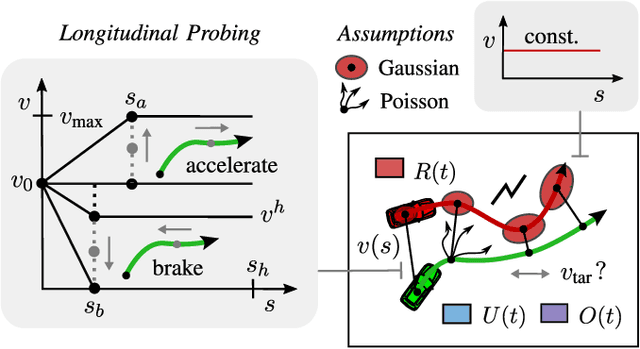
Abstract:The survival analysis of driving trajectories allows for holistic evaluations of car-related risks caused by collisions or curvy roads. This analysis has advantages over common Time-To-X indicators, such as its predictive and probabilistic nature. However, so far, the theoretical risks have not been demonstrated in real-world environments. In this paper, we therefore present Risk Maps (RM) for online warning support in situations with forced lane changes, due to the end of roads. For this purpose, we first unify sensor data in a Relational Local Dynamic Map (R-LDM). RM is afterwards able to be run in real-time and efficiently probes a range of situations in order to determine risk-minimizing behaviors. Hereby, we focus on the improvement of uncertainty-awareness and transparency of the system. Risk, utility and comfort costs are included in a single formula and are intuitively visualized to the driver. In the conducted experiments, a low-cost sensor setup with a GNSS receiver for localization and multiple cameras for object detection are leveraged. The final system is successfully applied on two-lane roads and recommends lane change advices, which are separated in gap and no-gap indications. These results are promising and present an important step towards interpretable safety.
Proactive Risk Navigation System for Real-World Urban Intersections
Mar 14, 2023
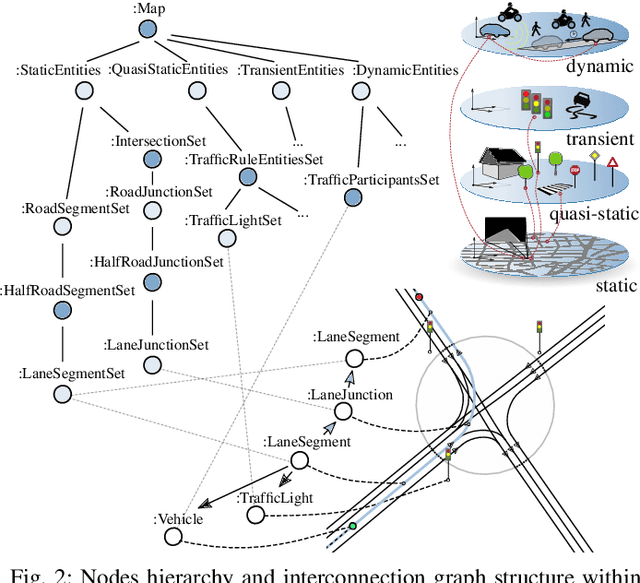


Abstract:We consider the problem of intelligently navigating through complex traffic. Urban situations are defined by the underlying map structure and special regulatory objects of e.g. a stop line or crosswalk. Thereon dynamic vehicles (cars, bicycles, etc.) move forward, while trying to keep accident risks low. Especially at intersections, the combination and interaction of traffic elements is diverse and human drivers need to focus on specific elements which are critical for their behavior. To support the analysis, we present in this paper the so-called Risk Navigation System (RNS). RNS leverages a graph-based local dynamic map with Time-To-X indicators for extracting upcoming sharp curves, intersection zones and possible vehicle-to-object collision points. In real car recordings, recommended velocity profiles to avoid risks are visualized within a 2D environment. By focusing on communicating not only the positional but also the temporal relation, RNS potentially helps to enhance awareness and prediction capabilities of the user.
 Add to Chrome
Add to Chrome Add to Firefox
Add to Firefox Add to Edge
Add to Edge